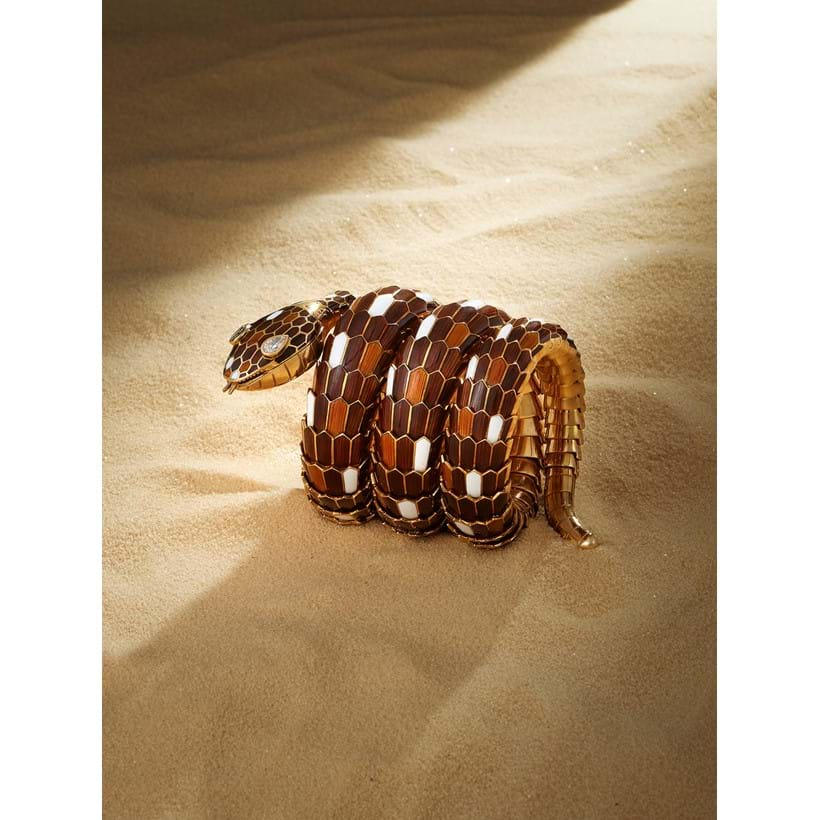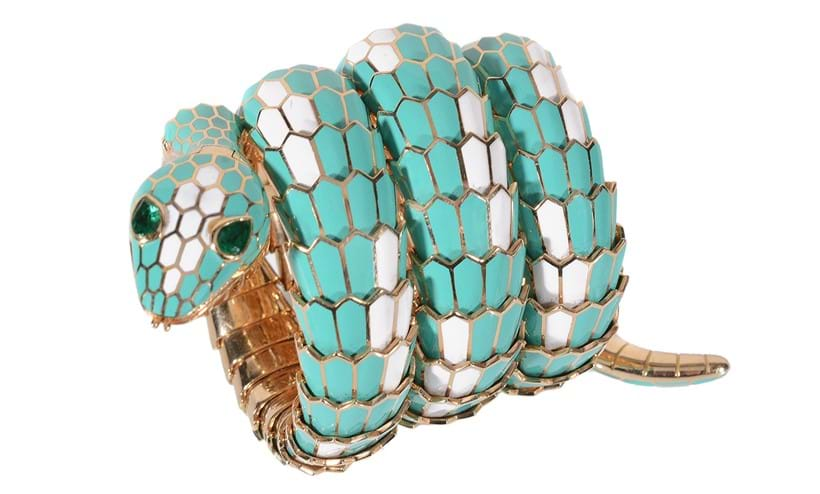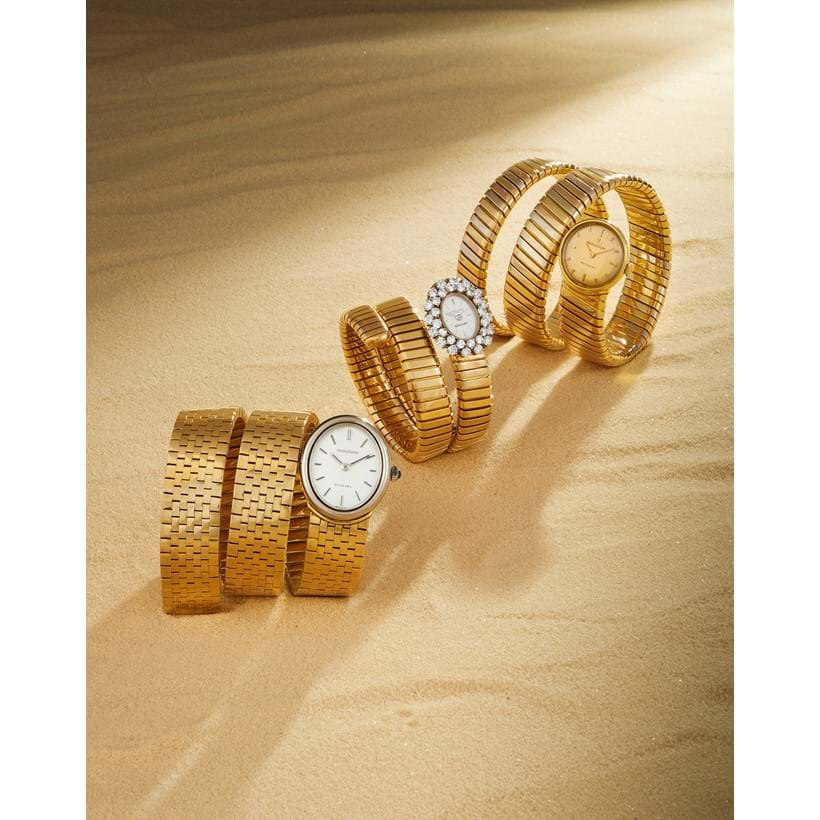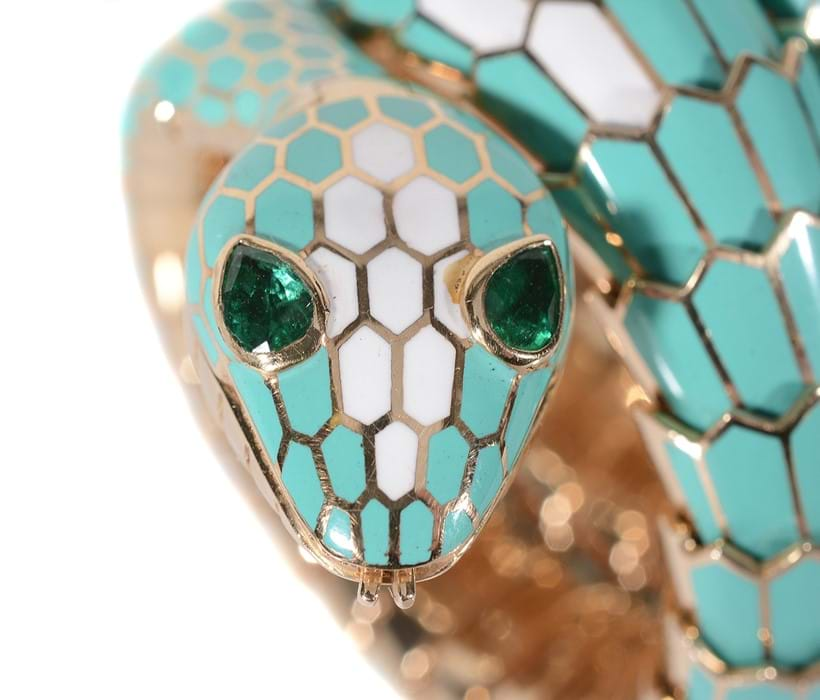Bulgari Serpenti – History, Legacy and Reinvention
Coming up this summer, we have our Fine Jewellery, Silver, Watches and Luxury Accessories auction on Tuesday 18 June. The auction features a selection of Bulgari Serpenti watches, which come to auction from a private collection. Here, Head of Jewellery, Charlotte Peel tells us more about the history and design of these iconic watches.

Bulgari
Bulgari, known as the quintessential Roman jeweller, was established by Sotirio Boulgaris, a Greek silversmith whose name was later Italianized to Bulgari. Born in Epirus, northern Greece in 1857, Sotirio hailed from a family with a rich tradition of silver craftsmanship. His journey led him to Rome in 1881, after passing through Corfu and Naples. Setting up shop in 1884 on via Sistina, he offered an array of "artistic" silverwork, antiques, curiosities, and jewellery. The following year, he opened another store at 28 via Condotti.
In 1905, Bulgari shifted its focus to jewellery, and together with his sons Costantino and Giorgio they inaugurated a shop at 10 via Condotti, near the Spanish Steps—a location that remains the brand's focal point. They elevated Bulgari's creativity and reputation, with Giorgio particularly involved in sourcing stones and nurturing the brand's artistic direction, drawing inspiration from its Greek origins and Roman heritage, as evidenced by its incorporation of ancient coins and archaeological revival motifs into its design. After Sotirio's passing in 1932, his sons continued the legacy, joined by Giorgio's three sons: Gianni, Paolo, and Nicola.
The 1960s marked the emergence of Bulgari's distinctive style, characterized by bold, architectural designs and vibrant coloured stones, particularly cabochons. Bulgari's global expansion attracted a prestigious clientele, including renowned figures like Sophia Loren and Elizabeth Taylor, cementing its influence on jewellery design through the years from 1980 to the present day.
Snakes in Jewellery Design
In the realm of jewellery, the sinuous elegance of snakes has long captivated artisans and wearers alike. None more so than Bulgari's iconic Serpenti collection, a timeless symbol of transformation and allure. Since its inception 76 years ago in 1948, this collection has dazzled connoisseurs with its ever-evolving iterations, akin to a snake shedding its skin.
A serpent's cunning allure has woven its way through countless tales since the dawn of humanity, from tempting Eve with an apple in the Garden of Eden to adorning the crowns of ancient pharaohs as a symbol of protection and authority. Throughout history, civilizations like the Greeks, Romans, and Egyptians have revered and feared these reptilian creatures, shaping myths and legends that endure to this day.
Notable figures like Cleopatra and Queen Victoria adorned themselves with serpent-inspired jewellery, imbuing the pieces with symbolism of beauty, seduction, and eternal love.

The Bulgari Serpenti Collection
The inaugural Bulgari Serpenti creation emerged in 1948: a bracelet-watch crafted in gold, featuring a square dial nestled within a head that gracefully coils around the wrist. Executed in the Tubogas technique, the flexible bracelet-watch boasted seamless coils of gold, ensuring both comfort and elegance.
As the years progressed, the design evolved in the 1950s, embracing a more serpentine aesthetic. The addition of a lifelike serpent head adorned with precious gemstones like diamonds, rubies, sapphires, or emeralds for eyes lent an air of realism and opulence. Ingeniously, the Bulgari Serpenti concealed its watch dial discreetly within the serpent's mouth, earning it the moniker of a "secret watch" within the industry.
By the 1960s, Bulgari elevated the sophistication of the Serpenti bracelet-watch further, introducing colourfully enamelled scales to decorate the body. Vibrant enamel and an array of gemstones, including lapis lazuli, coral, jade, onyx, and turquoise, embellished these designs, adding a burst of colour and luxury. The Serpenti gained cult status in the 1960s, fuelled by Elizabeth Taylor's portrayal of Cleopatra and a photograph of her wearing her newly acquired Serpenti watch on set in Rome in 1962.
Some pieces draw inspiration from specific snake species, with subtle engravings of their names delicately placed on the tails. For instance, a bracelet featuring vibrant blue, red, and black hues mirrors the polychromatic milk snake's pattern, while a yellow and red enamel watch bracelet takes cues from the yellow rat snake. Other enamel snakes, however, embrace colours found in fashion rather than nature.
Crafting these enamel pieces demanded rare technical skill. Each gold pentagon-shaped scale was meticulously enamelled, then fired in an oven before being assembled with tiny screws. The majority of scales in 1960s designs were adorned with opaque enamel, while select scales featured engraved lines on gold, adding texture beneath colourful, shiny, transparent enamels.

Inside the serpent bodies, a gold spring ensures flexible sizing, while precious gems accentuate the eyes and sometimes the watch bezels, discreetly hidden within the mouth, from which a forked tongue emerges. The Serpenti's flexibility captivated admirers like Diana Vreeland, who even wore a Serpenti belt coiled around her neck. Bulgari collaborated with esteemed watchmakers like Jaeger-LeCoultre and Vacheron Constantin to craft the movements for these enamel snake jewels.
These rare designs, numbering fewer than one hundred, primarily comprised bracelets, with only a handful of belts ever produced. Despite their scarcity, the enamel snakes swiftly became emblematic of Bulgari's artistry. In the 1970s, they starred in a famous series of Bulgari advertisements, depicted wrapped around a large 'B,' alongside the next generation of snake-inspired jewellery—the Tubogas watch-bracelets.
The Tubogas style experienced a revival in the late 1960s and 1970s, with geometrically shaped watch dials complementing the sinuous bracelets. Their simplicity reflected a wider move of jewellery to suit a more casual lifestyle and take women from the office to dinner. Gianni Bulgari was quoted in 1970 saying: “People no longer want something they put on or carry for great occasions, but jewellery they wear often with many things.”
A distinctive brickwork pattern of gold adorns several of the latest iterations of snake watch bracelets, but Tubogas remains the predominant choice, enduring to the present day. Bulgari artisans honed their expertise in crafting these remarkably flexible coiled creations, meticulously wrapping two elongated gold strips with raised edges around a core. This technique ensures the edges firmly interlock, forming a seamless and continuous piece without the need for soldering. The core is then removed or dissolved, leaving behind the signature Tubogas coil.
The Tubogas pieces of the 1970s epitomized a cutting-edge aesthetic. Among the Bulgari acquisitions of the era was Andy Warhol's triple-coil Tubogas snake watch-bracelet, a testament to its allure. Warhol himself acclaimed Bulgari as "the most important museum of contemporary art" and made it a point to visit whenever he was in Rome.

Collaborations with established watchmakers such as Jaeger-LeCoultre and Vacheron Constantin persisted into the early 1970s, resulting in timepieces bearing the dual signatures of Bulgari and the respective watchmaker. However, Bulgari's horological endeavors took a significant leap forward in 1978 with the establishment of Bulgari Time, Write & Light, a manufacturing facility in Switzerland. Subsequently, Tubogas watches exclusively featured Bulgari-made movements, marking a milestone in the brand's watchmaking evolution
Bulgari's Serpenti collection stands as a testament to the brand's boundless creativity, boasting more variations than any other collection in its illustrious history. With continuous plans for creative production, the Serpenti Collection shows no signs of slowing down, promising a steady stream of exceptional jewellery and dazzling accessories. This ongoing commitment reaffirms the snake as an eternal symbol of Bulgari's legacy.
The seamless blend of history and contemporary style inherent in the Serpenti collection epitomizes Bulgari's aesthetic, solidifying its status as a revered name in the world of luxury jewellery. By infusing ancient symbolism with modern design sensibilities, Bulgari continues to captivate and inspire, ensuring its place at the forefront of haute joaillerie.
View Page Turning Catalogue
Auction Details
Tuesday 18 June, 10.30am BST
Donnington Priory, Newbury, Berkshire RG14 2JE
Browse the auction
Sign up to email alerts
VIEWING:
- Viewing in London (highlights)
- Tuesday 4 June: 10am-4pm
- Wednesday 5 June: 10am-4pm
- Viewing in Newbury (full sale)
- Friday 14 June: 10am-4pm
- Sunday 16 June: 10am-3pm
- Monday 17 June: 10am-4pm
- Remote Viewing Service | Available from Friday 14 June















